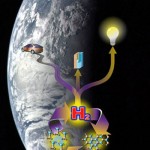
 Researchers have revealed a new single-stage method for recharging the hydrogen storage compound ammonia borane. The breakthrough makes hydrogen a more attractive fuel for vehicles and other transportation modes.
Researchers have revealed a new single-stage method for recharging the hydrogen storage compound ammonia borane. The breakthrough makes hydrogen a more attractive fuel for vehicles and other transportation modes.
Hydrogen is in many ways an ideal fuel. It possesses a high energy content per unit mass when compared to petroleum, and it can be used to run a fuel cell, which in turn can be used to power a very clean engine. On the down side, H2 has a low energy content per unit volume versus petroleum (it is very light and bulky). The crux of the hydrogen issue has been how to get enough of the element on board a vehicle to power it a reasonable distance.
Work at Los Alamos National Laboratory (LANL) and elsewhere has focused on chemical hydrides for storing hydrogen, with one material in particular, ammonia borane, taking center stage. Ammonia borane is attractive because its hydrogen storage capacity approaches a whopping 20 percent by weight—enough that it should, with appropriate engineering, permit hydrogen-fueled vehicles to go farther than 300 miles on a single “tank,” a benchmark set by the U.S. Department of Energy.
Hydrogen release from ammonia borane has been well demonstrated, and its chief drawback to use has been the lack of energy-efficient methods to reintroduce hydrogen into the spent fuel once burned. In other words, until now, after hydrogen release, the ammonia borane couldn’t be recycled efficiently enough.
The paper describes a simple scheme that regenerates ammonia borane from a hydrogen depleted “spent fuel” form (called polyborazylene) back into usable fuel via reactions taking place in a single container. This “one pot” method represents a significant step toward the practical use of hydrogen in vehicles by potentially reducing the expense and complexity of the recycle stage. Regeneration takes place in a sealed pressure vessel using hydrazine and liquid ammonia at 40 degrees Celsius and necessarily takes place off-board a vehicle. The researchers envision vehicles with interchangeable hydrogen storage “tanks” containing ammonia borane that are used, and sent back to a factory for recharge.
The Chemical Hydrogen Storage Center of Excellence was one of three Center efforts funded by DOE. The other two focused on hydrogen sorption technologies and storage in metal hydrides. The Center of Excellence was a collaboration between Los Alamos, Pacific Northwest National Laboratory, and academic and industrial partners.
LANL researcher Dr. John Gordon, a corresponding author for the paper, credits collaboration encouraged by the Center model with the breakthrough.
“Crucial predictive calculations carried out by University of Alabama Professor Dave Dixon’s group guided the experimental work of the Los Alamos team, which included researchers from both the Chemistry Division and the Materials Physics and Applications Division at LANL,” Gordon said.



